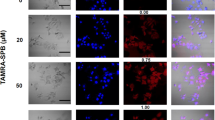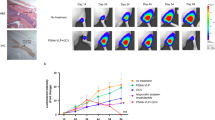Abstract
We have developed unique replication-competent retroviral (RCR) vectors based on murine leukemia virus that provide improved efficiency of viral delivery, allow for long-term transgene expression and demonstrate an intrinsic selectivity for transduction of rapidly dividing tumor cells. The purpose of this study was to evaluate the in vivo transduction efficiency and the therapeutic efficacy of the RCR vector mediated delivery of Escherichia coli purine nucleoside phosphorylase (PNP) in combination with fludarabine phosphate for bladder cancer. We constructed vectors containing green fluorescent protein (GFP) gene (ACE)-GFP) or PNP gene (ACE-PNP). KU-19-19 bladder tumors exhibited 28.3±16.1, 46.6±5.8 and 93.7±7.8% of GFP expression on 14, 18 and 26 days after intratumoral injection of ACE-GFP, respectively. GFP expression could not be observed in normal tissues surrounding the injected tumors. No detectable polymerase chain reaction products of GFP gene could be observed in any distant organs. Intratumoral injection of ACE-PNP, followed by systemically administered fludarabine phosphate, significantly inhibited the growth of pre-established KU-19-19 tumors. Our results indicate that RCR vectors are a potentially efficient gene delivery method and that the RCR vector mediated PNP gene transfer and fludarabine phosphate treatment might be a novel and potentially therapeutic modality for bladder cancer.
This is a preview of subscription content, access via your institution
Access options
Subscribe to this journal
Receive 12 print issues and online access
$259.00 per year
only $21.58 per issue
Buy this article
- Purchase on Springer Link
- Instant access to full article PDF
Prices may be subject to local taxes which are calculated during checkout







Similar content being viewed by others
References
van der Meijden AP . Bladder cancer. BMJ 1998; 317: 1366–1369.
Pawinski A, Sylvester R, Kurth KH, Bouffioux C, van der Meijden A, Parmar MK et al. A combined analysis of European Organization for Research and Treatment of Cancer, and Medical Research Council randomized clinical trials for the prophylactic treatment of stage TaT1 bladder cancer. European Organization for Research and Treatment of Cancer Genitourinary Tract Cancer Cooperative Group and the Medical Research Council Working Party on Superficial Bladder Cancer. J Urol 1996; 156: 1934–1940.
Sutton MA, Berkman SA, Chen SH, Block A, Dang TD, Kattan MW et al. Adenovirus-mediated suicide gene therapy for experimental bladder cancer. Urology 1997; 49: 173–180.
Mohr L, Shankara S, Yoon SK, Krohne TU, Geissler M, Roberts B et al. Gene therapy of hepatocellular carcinoma in vitro and in vivo in nude mice by adenoviral transfer of the Escherichia coli purine nucleoside phosphorylase gene. Hepatology 2000; 31: 606–614.
Voeks D, Martiniello-Wilks R, Madden V, Smith K, Bennetts E, Both GW et al. Gene therapy for prostate cancer delivered by ovine adenovirus and mediated by purine nucleoside phosphorylase and fludarabine in mouse models. Gene Ther 2002; 9: 759–768.
Logg CR, Logg A, Tai CK, Cannon PM, Kasahara N . Genomic stability of murine leukemia viruses containing insertions at the Env-3′ untranslated region boundary. J Virol 2001; 75: 6989–6998.
Logg CR, Tai CK, Logg A, Anderson WF, Kasahara N . A uniquely stable replication-competent retrovirus vector achieves efficient gene delivery in vitro and in solid tumors. Hum Gene Ther 2001; 12: 921–932.
Tachibana M, Miyakawa A, Nakashima J, Murai M, Nakamura K, Kubo A et al. Constitutive production of multiple cytokines and a human chorionic gonadotrophin beta-subunit by a human bladder cancer cell line (KU-19-19): possible demonstration of totipotential differentiation. Br J Cancer 1997; 76: 163–174.
Wang WJ, Tai CK, Kasahara N, Chen TC . Highly efficient and tumor-restricted gene transfer to malignant gliomas by replication-competent retroviral vectors. Hum Gene Ther 2003; 14: 117–127.
Anderson WF, McGarrity GJ, Moen RC . Report to the NIH Recombinant DNA Advisory Committee on murine replication-competent retrovirus (RCR) assays (February 17, 1993). Hum Gene Ther 1993; 4: 311–321.
Donahue RE, Kessler SW, Bodine D, McDonagh K, Dunbar C, Goodman S et al. Helper virus induced T cell lymphoma in nonhuman primates after retroviral mediated gene transfer. J Exp Med 1992; 176: 1125–1135.
Da Costa LT, Jen J, He TC, Chan TA, Kinzler KW, Vogelstein B . Converting cancer genes into killer genes. Proc Natl Acad Sci USA 1996; 93: 4192–4196.
Huber BE, Austin EA, Good SS, Knick VC, Tibbels S, Richards CA . In vivo antitumor activity of 5-fluorocytosine on human colorectal carcinoma cells genetically modified to express cytosine deaminase. Cancer Res 1993; 53: 4619–4626.
Parker WB, King SA, Allan PW, Bennett Jr LL, Secrist III JA, Montgomery JA et al. In vivo gene therapy of cancer with E. coli purine nucleoside phosphorylase. Hum Gene Ther 1997; 8: 1637–1644.
Johnson S, Smith AG, Loffler H, Osby E, Juliusson G, Emmerich B et al. Multicentre prospective randomised trial of fludarabine versus cyclophosphamide, doxorubicin, and prednisone (CAP) for treatment of advanced-stage chronic lymphocytic leukaemia. The French Cooperative Group on CLL. Lancet 1996; 347: 1432–1438.
Estey EH, Thall PF, Pierce S, Cortes J, Beran M, Kantarjian H et al. Randomized phase II study of fludarabine + cytosine arabinoside + idarubicin +/− all-trans retinoic acid +/− granulocyte colony-stimulating factor in poor prognosis newly diagnosed acute myeloid leukemia and myelodysplastic syndrome. Blood 1999; 93: 2478–2484.
Acknowledgements
We thank Maria E Dudas and Minglan Lu (Department of Pathology, Memorial Sloan-Kettering Cancer Center, New York, NY) for their expert technical assistance. This work was funded in part by P01 CA59318 (Project 2) and R01 CA105171. This work was supported by a grant from The Allbritton Foundation.
Author information
Authors and Affiliations
Corresponding author
Rights and permissions
About this article
Cite this article
Kikuchi, E., Menendez, S., Ozu, C. et al. Delivery of replication-competent retrovirus expressing Escherichia coli purine nucleoside phosphorylase increases the metabolism of the prodrug, fludarabine phosphate and suppresses the growth of bladder tumor xenografts. Cancer Gene Ther 14, 279–286 (2007). https://doi.org/10.1038/sj.cgt.7701013
Received:
Revised:
Accepted:
Published:
Issue Date:
DOI: https://doi.org/10.1038/sj.cgt.7701013
Keywords
This article is cited by
-
The use of Trichomonas vaginalis purine nucleoside phosphorylase to activate fludarabine in the treatment of solid tumors
Cancer Chemotherapy and Pharmacology (2020)
-
Radiosensitization of gliomas by intracellular generation of 5-fluorouracil potentiates prodrug activator gene therapy with a retroviral replicating vector
Cancer Gene Therapy (2014)
-
Tumor-targeting Salmonella typhimurium, a natural tool for activation of prodrug 6MePdR and their combination therapy in murine melanoma model
Applied Microbiology and Biotechnology (2013)
-
Armed and targeted measles virus for chemovirotherapy of pancreatic cancer
Cancer Gene Therapy (2011)
-
Adenovirus–Retrovirus Hybrid Vectors Achieve Highly Enhanced Tumor Transduction and Antitumor Efficacy In Vivo
Molecular Therapy (2011)



